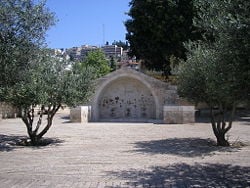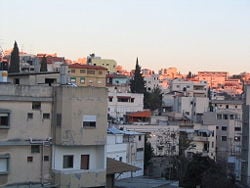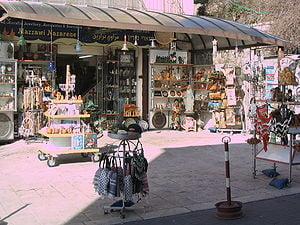Difference between revisions of "Nazareth" - New World Encyclopedia
m (→History) |
m (→History) |
||
| Line 33: | Line 33: | ||
==History== | ==History== | ||
===Earliest history and archaeological evidence=== | ===Earliest history and archaeological evidence=== | ||
| − | |||
| − | |||
| − | |||
| − | |||
| − | |||
| − | |||
| − | |||
| − | |||
| − | |||
| − | |||
| − | |||
| − | |||
| − | |||
| − | |||
| − | |||
| − | |||
| − | |||
| − | |||
| − | |||
| − | |||
| − | |||
| − | |||
| − | |||
| − | |||
| − | |||
| − | |||
| − | |||
| − | |||
| − | |||
| − | |||
| − | |||
| − | |||
| − | |||
| − | |||
| − | |||
| − | |||
| − | |||
| − | |||
Archaeological research has revealed a funerary and [[cult]] center at Kfar HaHoresh, about two miles from Nazareth, dating roughly 9,000 years ago, in what is known as the [[Pre-Pottery Neolithic B]] era. The remains of some 65 individuals were found, buried under huge horizontal headstone structures, some of which consisted of up to three tons of locally produced white plaster. Decorated human skulls found have led archaeologists to believe that Kfar HaHoresh was a major cult center in that remote era. | Archaeological research has revealed a funerary and [[cult]] center at Kfar HaHoresh, about two miles from Nazareth, dating roughly 9,000 years ago, in what is known as the [[Pre-Pottery Neolithic B]] era. The remains of some 65 individuals were found, buried under huge horizontal headstone structures, some of which consisted of up to three tons of locally produced white plaster. Decorated human skulls found have led archaeologists to believe that Kfar HaHoresh was a major cult center in that remote era. | ||
Revision as of 19:39, 9 December 2008
| Nazareth | ||
| ||
| Hebrew | נָצְרַת (Natz'rat) | |
| (Standard) | Náẓərat | |
| Arabic | الناصرة (an-Nāṣira) | |
| Name meaning | Ancient word in Hebrew | |
| Government | City | |
| District | North | |
| Population | 64,800[1] (2006) | |
| Mayor | Ramiz Jaraisy | |
Nazareth is the capital and largest city in the North District of Israel. An ancient town, archaelogical excavations have revealed evidence from the Middle Roman, Crusader, Mamluk, and Ottoman periods. In the New Testament, it is described as the childhood home of Jesus, and is a center of Christian pilgrimage, with many shrines commemorating biblical associations. Today, Nazareth is the capital of the North District of Israel, as well as the largest Arab Israeli city in Israel.
Etymology
The etymology of Nazareth from as early as Eusebius (fourth century CE) up until the twentieth century has been said to derive from netser, a "shoot" or "sprout," related to messianic prophecies concerning the Davidic Messiah as the "shoot of Jesse." The apocryphal Gospel of Phillip derives the name from Nazara meaning "truth." There is also speculation and biblical indications that "Nazarene" meaning "of the village of Nazareth," was confused with "Nazirite," meaning a "separated" Jew who had taken a vow of holiness.
Geography & Population
Modern-day Nazareth is nestled in a hollow plateau some 1,200 feet above sea level, located between 1,600-foot-high hills that form the most southerly points of the Lebanon mountain range. It is about 15.5 miles from the Sea of Galilee and about six miles west from Mount Tabor. The main road for traffic between Egypt and the interior of Asia passes by Nazareth near the foot of Mount Tabor, and then northward to Damascus.
Nazareth has an estimated population of 70,000. The majority of residents are Arab citizens of Israel, about 35 to 40 percent of whom are Christians and 55 to 60 percent are Muslims. The adjacent city of Nazareth Illit has a population of 44,000 Israeli Jews.
History
Earliest history and archaeological evidence
Archaeological research has revealed a funerary and cult center at Kfar HaHoresh, about two miles from Nazareth, dating roughly 9,000 years ago, in what is known as the Pre-Pottery Neolithic B era. The remains of some 65 individuals were found, buried under huge horizontal headstone structures, some of which consisted of up to three tons of locally produced white plaster. Decorated human skulls found have led archaeologists to believe that Kfar HaHoresh was a major cult center in that remote era.
Nazareth plays a major role in Christian writings dating back to the Gospels, written in the second half of the first century. Population estimates for it range from its being a small village of a few dozen person to a town of up to 2,000. The Galilean seaport city of Sepphoris was undergoing major construction in the early first century CE, and many scholars now think that Nazareth may have functioned as kind of suburb, from which local workmen traveled to the construction jobs in Sepphoris. Some historians, however, argue that the absence of textual references to Nazareth in Jewish sources suggest that a town called 'Nazareth' did not truly exist in Jesus' day.[2] Nazareth is first mentioned in ancient Jewish sources in the third century CE.
A tablet currently at the Bibliotheque Nationale in Paris, dating to 50 C.E., was sent from Nazareth to Paris in 1878. It contains an inscription known as the "Ordinance of Caesar" that outlines the penalty of death for those who violate tombs or graves. However, it is suspected that this inscription came to Nazareth from somewhere else (possibly Sepphoris).
In the mid-1990s, shopkeeper Elias Shama discovered tunnels under his shop near Mary’s Well in Nazareth. The tunnels were eventually recognized as a space below the floor into which warm air was pumped for a bathhouse. The site was excavated in 1997-1998 by Y. Alexandre, and the archaeological remains exposed were ascertained to date from the Middle Roman, Crusader, Mamluk, and Ottoman periods.
New Testament associations

According to the New Testament, Nazareth was the home of Joseph and Mary, the site of the Annunciation when Mary was told by the angel Gabriel that she would have Jesus as her son, the location where Jesus grew up from his infancy to manhood.
The Gospels of Matthew and Luke differ as the role of Nazareth in Jesus' infancy. Matthew describes the family as traveling from Bethlehem to Egypt, which a large population of Jews lived at Alexandria and its environs, returning to Judea only after the death of Herod the Great and deciding to settle in Nazareth. The Gospel of Luke, however, describes the Mary and Joseph as returning to Nazareth immediately after presenting Jesus at the Temple in Jerusalem as an infant.
In John 1:46, Nathaniel asks, "Can anything good come out of Nazareth?" The meaning of this cryptic question is debated. Some commentators suggest that it means Nazareth was very small and unimportant. But the question does not speak of Nazareth’s size but of its goodness. Nazareth was viewed with some hostility by the evangelists because it rejected Jesus' ministry and “he could do no mighty work there” (Mk 6:5). In all four gospels we read the famous saying, “A prophet is not without honor except in his own country, and among his own kin, and in his own house” (Mt 13:57; Mk 6:4; Lk 4:24; Jn 4:44). In one passage the people of Nazareth even attempt to kill Jesus by throwing him off a cliff (Lk 4:29).
The first non-biblical references to Nazareth are relatively late. In 200 C.E., Julius Africanus, cited by Eusebius (Church History 1.7.14), speaks of “Nazara” as a village in "Judea" and locates it near an as-yet unidentified “Cochaba.” This curious description does not fit the traditional location of Nazareth in Lower Galilee and is likely due simply to the author's ignorance of Palestinian geography. However, several possible Cochabas have been identified: one 9.3 miles north of Nazareth (on the other side of Sepphoris); one in the region of Bashan (to the East of the Jordan River); and two near Damascus.
In 1962, a Hebrew inscription found in Caesarea, dating to the late third or early fourth century, mentions Nazareth as one of the places in which the priestly family of Hapizzez was residing after the Bar Kokhba revolt (132-135 C.E.).
Jerome, writing in the fifth century, says Nazareth was still a viculus or mere village in his day. In the sixth century, however, legends about Mary began to spark interest in the site among pilgrims, who founded the Church of the Annunciation at the site of a freshwater spring, today known as St. Mary's Well.
Islamic rule
The Muslim conquest of Palestine in 637 C.E. during the early medieval period eventually led to the First Crusade, which began an extended period of conflict. Control over Galilee and Nazareth shifted frequently during this time, with corresponding impact on the religious makeup of the population.
In 1099 C.E., the Crusader Tancred captured Galilee and established his capital in Nazareth. The ancient diocese of Scythopolis was also relocated under the Archbishop of Nazareth. The town returned to Muslim control in 1187 C.E. following the victory of Saladin in the Battle of Hattin.
Christian control of the area resumed in 1229 C.E. as part of the events of the Sixth Crusade, but ended in 1263 C.E. with the destruction of all Christian buildings by the Sultan Baibars and the expulsion of the Christian population until Fakhr-al-Din II permitted their return in 1620 C.E.
1947-1948
Nazareth was in the territory allotted to the Arab state under the 1947 UN Partition Plan, near the southern border within the northernmost part. [1] The town was not a field of battle during 1948 Arab-Israeli War before the first truce on June 11, although some of the villagers had joined the loosely organized peasant resistance forces, and troops from the Arab Liberation Army had entered Nazareth.
During the 10 days of fighting which occurred between the first and second truce, Nazareth capitulated July 16 to Israeli troops during Operation Dekel, after little more than token resistance. The surrender was formalized in a written agreement, where the town leaders agreed to cease hostilities in return for promises from the Israeli officers, including brigade commander Ben Dunkelman, (the leader of the operation), that no harm would come to the civilians of the town. A few hours later Chaim Laskov gave order to Dunkelman to evacuate the civilian population of Nazareth. Dunkelman refused to obey these orders. In sharp contrast to the surrounding towns, the Arab inhabitants in Nazareth were therefore never forced out. However, the influx of Muslim Arab refugees from the surrounding villages and towns that were destroyed changed the population of Nazareth from having a Christian majority to having a Muslim majority.
Current Events
Preparations for the Pope's visit to Nazareth in 2000 triggered highly publicized tensions related to the Basilica of the Annunciation. The 1997 permission for construction of a paved plaza to handle the expected thousands of Christian pilgrims caused Muslim protests and occupation of the proposed site, which is considered the grave of a nephew of Saladin. This site used to be the home of a school built during the Ottoman rule. The school was named al-harbyeh (in arabic means military), and many elderly people in Nazareth still remember it as the the school site, never the less, the same site still contains,the Shihab-Eddin shrine, along with several shops owned by the Waqf (Muslim community ownership. This means the land is partly waqf (Islamic religious endowment)land. The school building continued to serve as a government school until it was demolished to allow for the plaza to be built.
The initial argument between the different political factions in town (represented in the local council), was on where the borders of the shrine and shops starts and where it ends. The initial government approval of subsequent plans for a large mosque to be constructed at the site led to protests from Christian leaders worldwide, which continued after the papal visit. Finally, in 2002, a special government commission permanently halted construction of the mosque. In March 2006, public protests that followed the disruption of a Lenten prayer service by an Israeli Jew and his Christian wife and daughter, who detonated incendiary devices inside the church, succeeded in dismantling a temporary wall that had been erected around the public square that had been constructed but had yet to be unveiled, putting an end to the entire controversy.
On July 19, 2006 a rocket fired by the Lebanese Shia militant group Hezbollah as part of the 2006 Israel-Lebanon conflict killed two children in Nazareth. No holy sites were damaged.
Nazareth's football (soccer) team, Maccabi Akhi Nazareth, plays in the Nationwide League.
Religious Shrines
Nazareth is home to many churches which are its chief tourist attractions. The most important commemorate biblical events.
- The Church of the Annunciation is the largest Christian church building in the Middle East. In Roman Catholic tradition, it marks the site where the Archangel Gabriel announced the future birth of Jesus to the Virgin Mary (Luke 1:26-31).
- The Eastern Orthodox Church constructed St. Gabriel's Church at an alternative site for the Annunciation.
- The Melkite Greek Catholic Church owns the Synagogue Church, which is located at the traditional site of the synagogue where Jesus preached (Luke 4)
- The Church of St. Joseph's Carpentry occupies the traditional location for the workshop of Saint Joseph
- The Mensa Christi Church, run by the Franciscan religious order, commemorates the traditional location where Jesus dined with the Apostles after his Resurrection
- The Basilica of Jesus the Adolescent, run by the Salesian religious order, occupies a hill overlooking the city.
Notes
- ↑ http://www.cbs.gov.il/population/new_2007/table3.pdf
- ↑ R. Eisenman, James the Brother of Jesus. New York: Penguin Books, 1997, p. 952.
ReferencesISBN links support NWE through referral fees
- Benedict, Pope. Jesus of Nazareth: From the Baptism in the Jordan to the Transfiguration. New York: Doubleday, 2007. ISBN: 978-0385523417
- Emmett, Chad F. Beyond the Basilica: Christians and Muslims in Nazareth. Chicago: University of Chicago Press, 1995. ISBN 978-0226207117
- Israeli, Raphael. Green Crescent Over Nazareth: The Displacement of Christians by Muslims in the Holy Land. Portland, Ore.: F. Cass, 2002. ISBN 978-0714652580
- Shahin, Mariam. Palestine: A Guide. Interlink Books, 2005. ISBN 978-1566565578
External links
- Nazareth Official City Website
- Nazareth entry in historical sourcebook by Mahlon H. Smith
- W.R.F. Browning, Oxford Dictionary of the Bible
- Jewish Encyclopedia
Credits
New World Encyclopedia writers and editors rewrote and completed the Wikipedia article in accordance with New World Encyclopedia standards. This article abides by terms of the Creative Commons CC-by-sa 3.0 License (CC-by-sa), which may be used and disseminated with proper attribution. Credit is due under the terms of this license that can reference both the New World Encyclopedia contributors and the selfless volunteer contributors of the Wikimedia Foundation. To cite this article click here for a list of acceptable citing formats.The history of earlier contributions by wikipedians is accessible to researchers here:
The history of this article since it was imported to New World Encyclopedia:
Note: Some restrictions may apply to use of individual images which are separately licensed.

